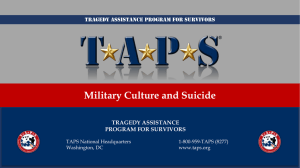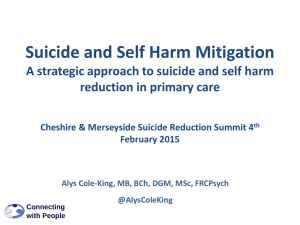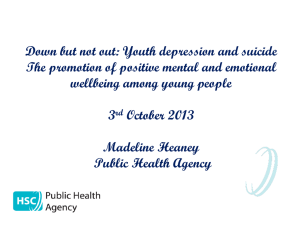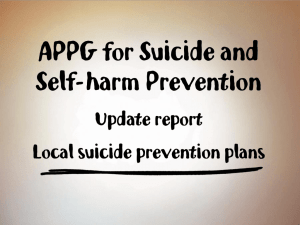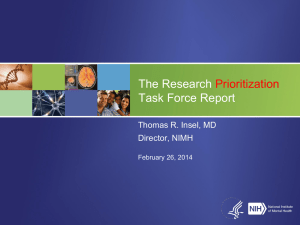1800-273-TALK (8255)
advertisement
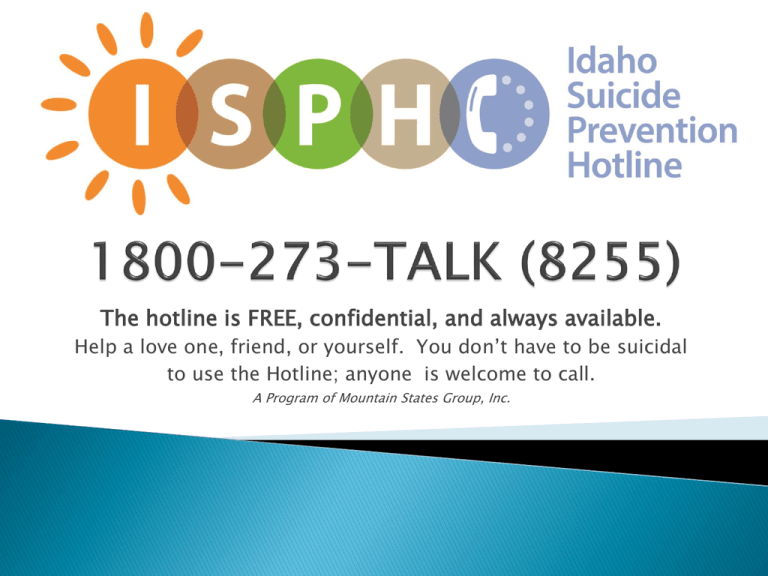
The hotline is FREE, confidential, and always available. Help a love one, friend, or yourself. You don’t have to be suicidal to use the Hotline; anyone is welcome to call. A Program of Mountain States Group, Inc. 5 years-Crisis Clinic of King County 8 years- Idaho H&W Mobile Crisis Unit 4 years- St Alphonsus emergency dept. mental disorder, past suicide attempts, social isolation, physical illness, unemployment, family conflict, family history of suicide, impulsivity, incarceration, hopelessness, seasonal variation, serotonergic dysfunction, agitation/sleep, childhood abuse, exposure to suicide, homelessness Thomas Joiner, Phd Clinical Faculty Florida State University Author of Books Including: Why People Die by Suicide, Lonely at the Top, Myths About Suicide Survivor of Suicide 1.Thwarted Belongingness-we have a fundamental need to belong 2. Perceived Burdensomeness-feeling that my suicide would be a relief to others (together these lead to hopelessness when seen as unchangeable -and active suicidal desire) 3. Acquired Ability for self-harm-in response to repeated exposure to physically painful and/or trauma/ fear-inducing experiences-leading to reduced fear of suicide &increased pain tolerance 90% of people who die by suicide had a diagnosable psychiatric disorder at the time of their death. Many were under the care of a primary care physician or other medical specialist. One study found that 20% of older patients who committed suicide had visited their primary care physician on the same day as their suicide, 40% had visited their primary care physician within one week and 70% within one month. Provides education Straightforward roles for everyone in your practice setting Common sense tools for staff and patients Resources for treatment and ongoing monitoring/follow up for patients with thoughts to suicide. Getting started- 1.Communicate with staff about the new suicide prevention initiative in your office. 2. Meet to develop the “Office Protocol” for potentially suicidal patients. See the “Office Protocol Development Guide” instruction sheet in the Toolkit. 3. Schedule trainings for staff members according to individuals’ prevention responsibilities determined in Step 2. 4. Develop a referral network to facilitate the collaborative care of suicidal patients. Use the “Developing Mental Health Partnerships” materials in the Toolkit. 5.Read the Toolkit’s “Primer”. Providers may wish to study the last two sections on Suicide Risk Assessment and Intervention first. The first three sections may then be reviewed in order to gain knowledge about Prevalence, Comorbidity, Epidemiology, and Prevention. 6.Order community and patient education tools, such as suicide prevention posters/brochures. • The last Idaho hotline closed in 2006 • Idaho - last state in the US to be without a statewide suicide hotline • Planning efforts –Technical Work Group • 2011 UWTV Community Assessment –quality mental health support • Initial Funders and Supporters • 2013 UWTV Community Impact- access to quality mental health services • Launch • Current Model • Quality Program • Research Based • Accreditation • Training • Volunteers • Suicide in Idaho • Staff Information • Program Outcomes- Call Summary • Populations and Areas of Idaho Impacted • Caller Needs/Issues Financial 11% Physical Addiction Health 5% 9% Suicide 26% Interpersonal 20% Mental Health 29% • • 12% of total call volume for 2013 Collaboration with local resources, IDVS, Veterans Administration & National Veteran’s Crisis Line • • • • • • • • • • • United Way of Treasure Valley Idaho State University: Planning Grant, Americorps Position Speedy Foundation Idaho Division of Veterans Services ID Dept. of Health and Welfare, Division of Behavioral Health Saint Alphonsus Suicide Prevention Action Network (SPAN) Idaho JA and Kathryn Albertson Foundation Saint Luke’s Health System Lion’s Club Sight and Hearing Foundation 211 Idaho, Schools, colleges and universities, police and emergency responders, hospitals, service providers • The Interpersonal Theory of Suicide- Thomas Joiner Order the WICHE Toolkit http://www.sprc.org • www.idahosuicideprevention.org www.facebook.com/idahosuicide prevention • ISPH outreach- Nancy Pounds <npounds@mtnstatesgroup.org> • General info- John Reusser <jreusser@mtnstatesgroup.org> • Volunteer interest-Nina Leary <nleary@mtnstatesgroup.org>





